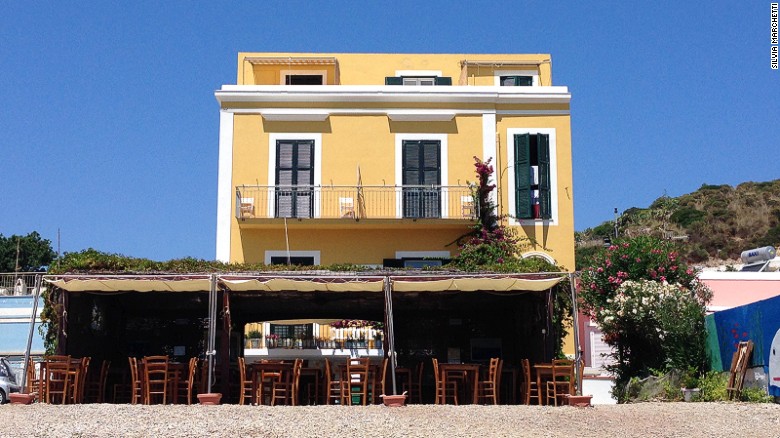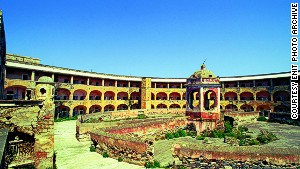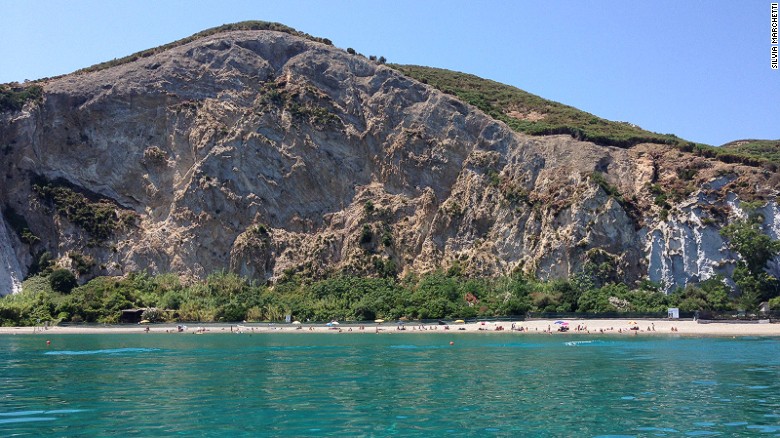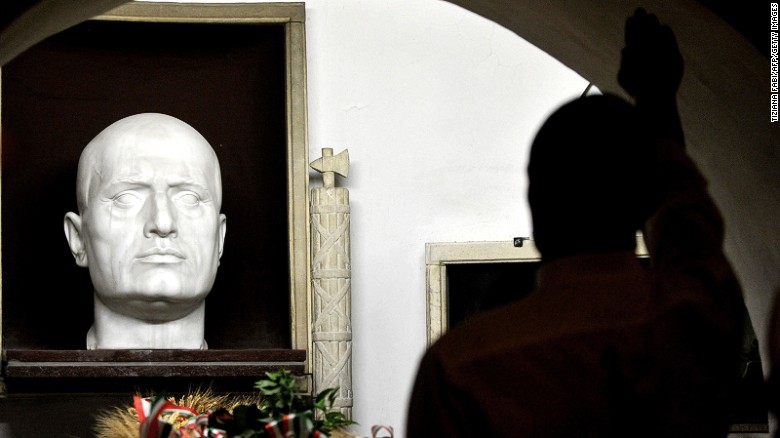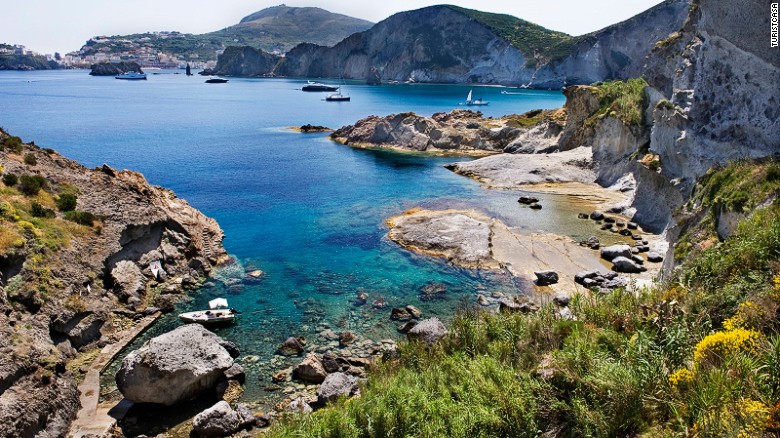
Dark humorists like to point out that Italian dictator Benito Mussolini’s only worthwhile historical contribution was getting trains to run on time.
They may have overlooked another legacy: tourist ambassador.
For better or worse, association with Adolf Hitler’s wartime ally is contributing to an unlikely boom for a few Italian destinations.
None more so than the west coast island of Ponza, where in July 1943 Mussolini was imprisoned after falling from power.
Here, memories of a scantily clad and amorous Mussolini still live large among locals now reaping rewards from his brief sojourn.
“He tried to seduce my grandmother down at the Frontone beach wearing a pair of white boxers,” says guesthouse owner Silveria Aroma, pointing at a faraway patch of sand crowded with sunbathers and playing children.
Even as a prisoner, guarded by police officers, the National Fascist Party leader was, apparently irrepressible.
“Mussolini was a Latin lover,” adds Aroma. “A typical Italian macho.”
As the owner of the cozy nine-bed Pensione Silvia, Aroma knows how to spin romantic tales about the tyrant’s brief “vacation.”
She’s not the only one.
Many islanders still trade in vivid, second-hand recollections of Mussolini walking around the village, writing a diary, meditating on his downfall and — perhaps strangely for a man who clashed with the Catholic Church early in his career — turning to God in prayer.
Ponza also exploits the Mussolini brand by staging hilarious summer performances about Il Duce that poke fun at him and his time on the island.
The Mussolini brand
Mussolini held his country in thrall from 1922 to 1943, until Italy’s declining fortunes in World War II led to him finally being overthrown and arrested.
To conceal his location from German forces who wished to reinstate him, the captured Mussolini was moved around over the course of 1943.
That’s how he came to spend 10 days on Ponza, a crescent-shaped atoll northwest of Naples.
More than 70 years on from those dark days, there’s a resurgent curiosity about and nostalgia for the man once known as Il Duce (“the leader”).
It sits alongside more troubling undercurrents of neo-fascism shown by the most zealous enthusiasts.
Ponza is one of several Italian locations exploiting the Mussolini brand to lure tourists.
It’s a fine line — a 1952 Italian law bans the public glorification of fascism.
Old habits die hard
“The local police still called him ‘His Excellence,'” recalls Silverio Capone, a former village councilor and amateur historian. “When he passed by people would cheer for him and give him the Fascist hand sign.”
“People had been for years fascist, how can you pretend that all of a sudden they become anti-fascist?”
A prison isle since Greek and Roman times, Mussolini had for decades confined his political enemies on Ponza.
Now it was his turn.
As Italy was still at war he found himself rubbing shoulders with socialists imprisoned under his regime.
At Pensione Silvia he is said to have slept in the bed once used by Ras Imru, Ethiopian guerrilla leader and cousin of Emperor Haile Selassie, who was held captive in Ponza after the Italian invasion of Ethiopia.
Swimming with Mussolini
Beyond the pension, Santa Maria bay has kept most of the charm once enjoyed by Mussolini.
In summer, colorful fishing boats bob alongside local families taking a dip in the same waters once enjoyed by Italy’s tyrant.
Aroma has more tales of local lore.
“You see that balcony on the second floor,” she says. “That’s where Mussolini spent most of his time, with his head in his hands, looking at the horizon, looming over his past and future.
“This was his prison-house. Our building was the biggest at that time, fit to host important people such as Ras Imru and Mussolini,” she adds proudly.
Room with a view
Pensione Silvia was painted white in Mussolini’s day. Now it’s yellow and pink with bright bougainvilleas growing on the walls.
The dictator’s one-time bedroom has a superb view of Ponza’s Roman harbor and picturesque fishing villages in the distance.
Roman grottoes are dotted on the skyline as well as the ruins of Emperor Augustus’ lavish summer retreat.
“His room has the best panorama of all and is the only one with two windows,” says Aroma. “It’s constantly overbooked.
“I kept one of Mussolini’s personal wooden chests, now at my place. It had secret drawers but I found nothing inside — too bad,” she laughs.
Lovers’ island
Mussolini was granted a privileged exile, very different from that endured by his political opponents.
He had the whole floor to himself — six rooms, a private studio, a personal laundrywoman and a cook to serve him freshly caught fish each day.
Above all, he was free to roam the island, although followed at a distance by guards.
“Mussolini loved to swim and take long strolls on Frontone beach,” says Aroma.
“That’s where he bumped into my grandmother. She was collecting dried seaweed for the pigsty, she was very young with fair skin and dark hair. A sort of 1940s pin-up.
“Mussolini was struck by her beauty and stopped her. He wanted to meet her again but the guards came up and told him to move on.”
Ponza is, after all, an island for lovers.
This is where, according to Homer, Odysseus was bewitched by the sorceress Circe, who used him as her sexual plaything.
Frontone beach today
In 1943, Frontone beach was deserted and wild.
Today it’s crowded with sun umbrellas and loungers, but still beautiful: pristine sands, overhanging granite crags and turquoise waters brimming with baby barracudas.
In the years since the war, celebrities including Kirk Douglas, Sophia Loren and Burt Lancaster also vacationed here.
Film director Wes Anderson chose Ponza as a location for his 2004 movie “The Life Aquatic with Steve Zissou.”
Spiritual crisis
Mussolini’s experiences of the island were less glamorous.
When not down the beach flirting in his white shorts, villagers say the toppled leader was in deep anguish, his political downfall having triggered in him a spiritual crisis.
The mythology that has built up around Il Duce in Ponza attributes to him acts of piety and stoicism.
It’s said that, fearful of his future, the only objects he arrived with were a book about Jesus and a photo of his dead son Bruno.
With no money or extra clothes, his first night on the island was reportedly spent on a wire bed without a mattress, using his jacket as a pillow.
“When he was taken away he gave all his clothes to the laundrywoman’s son,” says Aroma.
Milk for Mussolini
There was much sympathy among the locals for their fallen leader.
According to Capone, locals gave him their milk rations to help ease his stomach ulcers.
She shows a book of memoirs by Ponza’s local priest about his relationship with Mussolini.
It features a handwritten letter from Mussolini, asking the priest to celebrate mass in memory of his son Bruno and to pray for his soul. He enclosed a charity donation for orphans.
It seems the priest was also in awe of the dictator, waxing lyrical in his descriptions.
He never complained, writes the priest — he lost weight but still retained the fire in his eyes.
“Mussolini also got angry,” says Capone. “Walking through Ponza’s alleys he noticed that funds allocated by his government for roads maintenance and running water had never been spent. Deep down he was a real statesman.”
‘All is but a farce’
In April 1945, less than two years after his sojourn on Ponza, Mussolini and his mistress Clara Petacci were captured and executed by Italian anti-fascist partisans, their bodies hung on public display in Milan.
In a January 1945 interview, he spoke frankly, knowing the end was near.
“Now I am a corpse. I try, yet know that all is but a farce. I await the end of the tragedy and […] I do not feel any more an actor. I feel I am the last of the spectators.”
His speaking part may have ended, but the Mussolini show goes on.
The Mussolini industry: Key locations
Latina and Pontinia
Latina and Pontinia, near Rome, are living history.
The two cities were built by Mussolini on the former Pontine marshes and fascist monuments and symbols still stand in parks and on the streets.
The restaurant Impero in Latina was apparently Il Duce’s favorite.
He reportedly took his lovers there for lunch.
Campo Imperatore
Rifugio Campo Imperatore is a mountain lodge and ski resort high in Abruzzo’s Gran Sasso mountains, built in the 1930s under Mussolini’s regime.
The dictator was imprisoned here in August 1943, before being rescued by German commandos.
In true machismo style, it’s said he enjoyed skiing bare-chested here.
His room still features its original 1936 furnishings, right down to the bed sheets and bathroom.
Casa dei Ricordi
Casa dei Ricordi (House of Remembrance), near Forli, is a former Mussolini residence turned museum.
It showcases relics such as his violin, his rosary beads and fragments of a mortar bomb that wounded him.
Then there’s the gazebo where he used to read and the wooden garden house he built for his sons.
Tours are organized from here to Mussolini’s tomb in his home town of Predappio, a pilgrimage site for hundreds of neo-fascists pining for Italy’s lost “golden era.”
Homage is paid to the dictator three times a year, on the anniversaries of his birth, his death and the National Fascist Party’s March on Rome in 1922.
“The most beautiful experience of my life,” TripAdvisor user Peppisver writes of Casa dei Ricordi, in a post titled “The honor of Italy.” “It was as if the Duce was there with us to host us.”
[Source:- edition.cnn]

